 IST,
IST,


State of the Indian Economy
Dr. Rakesh Mohan, Deputy Governor, Reserve Bank of India
delivered-on നവം 07, 2006
It is my great pleasure to be here at the 2nd Annual Indian Securities Infrastructure & Operations Forum 2006. The recent growth momentum of the Indian economy is leading to renewed interest in India’s growth prospects. As the mid-year review of the annual policy is just over I thought instead of giving just a run-down of the current state of the Indian economy let me put the current trends into a broader perspective - both with respect to the longer term trend and as well as the global scenario. Thus, I will proceed as follows:
- In order to draw appropriate perspectives for the future of the Indian economy, I will first present an overview of India’s economic progress over the past three decades.
- Given the growing integration of the Indian economy with the rest of the world, I will then discuss the prospects of the global economy.
- This will be followed by an assessment of the current economic situation in India.
- Finally, I will discuss some of the issues necessary to accelerate the current growth momentum.
I. Overview of Longer-Term Trends
Growth, Savings and Investment
Following the initiation of structural reforms in the early 1990s, the Indian economy has grown at an annual average rate of over 6 per cent per annum. While the 1980s had also witnessed high growth (5.8 per cent per annum), this growth was associated with widening macroeconomic imbalances – growing fiscal deficits, growing current account deficits, falling international reserves and higher inflation – culminating in the balance of payments crisis of 1990-91. In contrast, not only has been there an acceleration in growth from 5.8 per cent during the 1980s to 6.4 per cent between 1992-93 and 2005-06, it has also been achieved in an environment of macroeconomic and financial stability, despite large exogenous shocks, both internal and external, over this period (Table 1).
|
Table 1 : India’s Real GDP Growth |
||
|
Period |
Average Annual |
Coefficient |
|
1 |
2 |
3 |
|
1970s |
2.9 |
1.42 |
|
1980s |
5.8 |
0.39 |
|
1990s |
5.8 |
0.32 |
|
2000-2006 |
6.4 |
0.32 |
|
Memo: |
||
|
1992-93 to 2005-06 |
6.4 |
0.24 |
More recently, real GDP growth has averaged more than 8 per cent per annum in the three-year period ended 2005-06. Taking into account the sharp deceleration in population growth over the past two decades, per capita real GDP growth has recorded a more impressive increase from 3.4 per cent per annum during the 1980s to around 6.5 per cent per annum in the recent three years. Developments in the current year so far suggest that the economy is on course to sustain the recent growth momentum in 2006-07.
The Indian economy is today the world’s second fastest growing economy after China. In terms of purchasing power parity (PPP) GDP, India is the world’s fourth largest economy after the US, China and Japan. India’s share in world GDP (PPP basis) has increased from 4.3 per cent in 1991 to almost 6.0 per cent in 2005 (Chart 1).
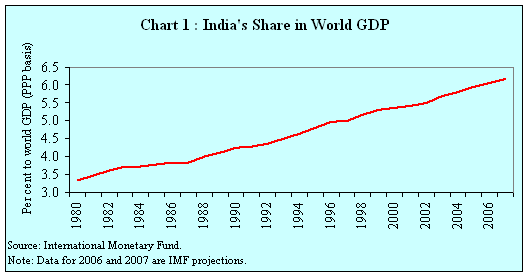
The step-up in the growth rate of the economy has been facilitated by increase in domestic investment to over 30 per cent of GDP, financed predominantly by domestic savings. Domestic savings increased to over 29 per cent of GDP by 2004-05 after some stagnation in the second half of the 1990s. The improvement in overall savings in recent years has particularly benefited from the turnaround in public sector savings. After turning negative between 1998-99 and 2002-03 owing to sharp deterioration in the savings of Government administration, public sector savings have turned positive again from 2003-04 onwards, mainly reflecting the ongoing fiscal consolidation. In 2004-05, the public sector savings rate was 2.2 per cent, but it was still less than a half of the peak of almost five per cent touched in 1976-77. Improvement in corporate profitability since 2002-03 has also contributed to increase in domestic savings in the recent years. Household savings remain the predominant component of domestic savings, contributing almost three-fourths of overall domestic savings in 2004-05. For the Indian economy to achieve higher growth on a sustained basis, further improvement in overall savings is necessary and, in this context, public sector savings will have to play a significant role (Table 2).
|
Table 2: Domestic Savings
in India |
||||
|
Period/Year |
Household |
Private |
Public |
Total |
|
1 |
2 |
3 |
4 |
5 |
|
1970s |
12.2 |
1.6 |
3.7 |
17.5 |
|
1980s |
14.6 |
1.8 |
3.0 |
19.4 |
|
1990s |
18.5 |
3.7 |
1.0 |
23.2 |
|
2000-2005 |
22.4 |
4.2 |
-0.2 |
26.3 |
|
Memo: |
22.0 |
4.8 |
2.2 |
29.1 |
Inflation
A notable macroeconomic achievement is in regard to inflation, which has seen a significant fall since the mid-1990s to an average of around 5 per cent per annum (from around 8 per cent per annum during the 1970s and 1980s) (Chart 2). The success with inflation management reflects largely pre-emptive monetary policy actions, in turn, facilitated by an improved monetary-fiscal interface. The forces of competition unleashed by growing openness and deregulation of the economy have also helped to contain the increase in domestic prices. Overall, the success with maintaining price stability has led to low and stable inflation expectations in the country. As cross-country experience tells us, inflation expectations play a key role in determining actual inflation movements. The success with maintaining price and financial stability in India has raised expectations of a structural shift in the medium-term growth path of the economy. Although inflation in India has indeed been significantly lower since the mid-1990s compared to the 1970s and 1980s, it needs to be stressed that inflation in India still remains higher than that of 2-3 per cent prevailing in major advanced economies.
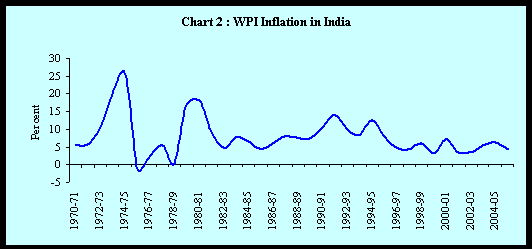
It is interesting to note that inflation in the country in the recent past has remained relatively benign despite large shocks from record high oil and other commodity prices. The Indian experience in this context is consistent with the recent experience in other countries; in the current episode of the oil shock, globally, inflation, has remained relatively modest compared to the kind of increase in inflation that took place due to the previous oil shocks. This is attributable to a number of factors such as declining intensity of oil usage, incomplete pass-through in some cases, higher competition and finally stable inflation expectations in view of pre-emptive monetary policy tightening. These issues are explored further in the next section.
Industrial Growth
A welcome feature of the strengthening of economic activity since 2003-04 has been the resurgence of manufacturing activity in the country (Charts 3 and 4). After recording high growth in the mid-1990s, the manufacturing sector exhibited stagnation till 2001-02. Since then, manufacturing has registered a gradual pick-up and this growth has been sustained in the current year so far. Notwithstanding the rebound in manufacturing activity, employment growth in manufacturing activity remains low (Table 3).
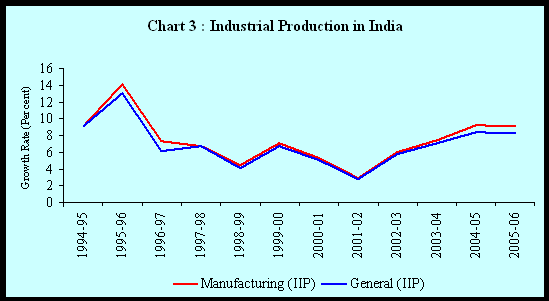
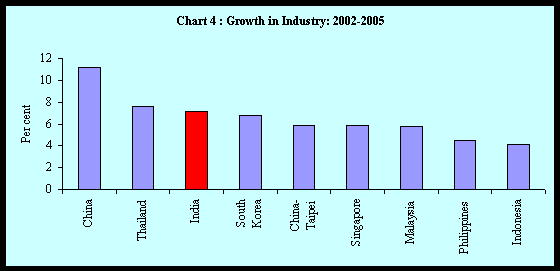
|
Table 3: Employment in
Industry |
||
|
Country/Year |
1980 |
2000 |
|
1 |
2 |
3 |
|
India |
13.9 |
18.2 |
|
Brazil |
24.7 |
19.3 |
|
China |
18.2 |
23.0 |
|
Indonesia |
13.2 |
17.3 |
|
South Korea |
29.0 |
28.0 |
|
Malaysia |
24.1 |
32.2 |
|
Mexico |
26.5 |
26.9 |
|
Thailand |
10.3 |
19.0 |
|
Turkey |
34.9 |
24.5 |
|
Source: Kalpana Kochhar, Utsav Kumar, Raghuram
Rajan, Arvind Subramanian and |
||
Growth in Bank Credit
The upturn in economic activity is mirrored in the sustained growth in demand for bank credit. Bank credit has increased sharply from 30 per cent of GDP at end-March 2000 to 48 per cent by end-March 2006 (Chart 5). Non-food credit extended by scheduled commercial banks (SCBs) recorded an average annual growth of 26.1 per cent between 2002-03 and 2005-06, notably higher than that of 14.5 per cent recorded during the preceding four-year period (1998-99 to 2001-02) as well as the long-run average of 17.8 per cent (1970-2006). The stagnation in credit flow observed during the late 1990s, in retrospect, was partly caused by reduction in demand on account of increase in real interest rates, turn down in the business cycle, and the significant business restructuring that occurred during that period. Apart from the revival of economic activity, the sharp growth in bank credit in the recent years can be attributed to factors such as financial deepening from a low base, structural shifts in supply elasticities, rising efficiency of credit markets and policy initiatives to improve flow of credit to sectors like the agriculture and small scale units. Increasingly, retail credit led by demand for housing as well as other retail loans is emerging as a major driver of growth in bank credit. This is reflected in the sharp increase in the share of housing credit in overall credit extended by SCBs from 2.4 per cent at end-March 1990 to 11.0 per cent at end-March 2005. Growth in retail credit has also emanated from increased use of credit cards, loans for consumer durables and demand for education loans. The share of non-housing retail credit in total bank credit has increased from four per cent at end-March 1990 to around 11 per cent at end-March 2005. Thus, the share of total retail credit in bank credit has increased from 6.4 per cent to over 22 per cent in the past 15 years (Chart 6). As a result of these trends, the share of industry in total credit has been falling since the late 1990s (Chart 7).
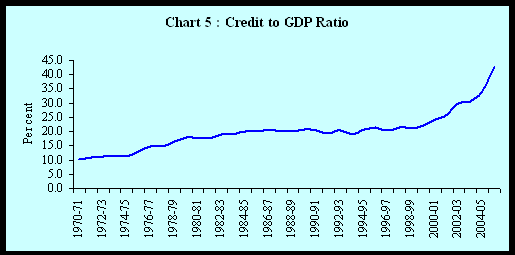
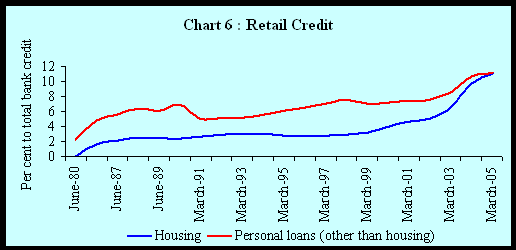
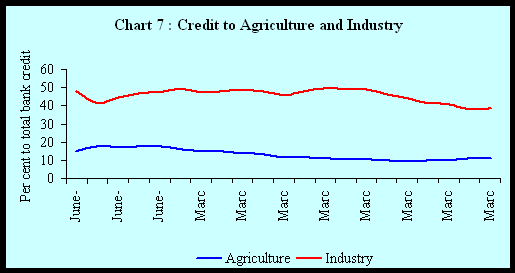
External Sector
The external sector has witnessed dramatic transformation over the past 15 years. There is growing integration of the Indian economy with the rest of the world. In contrast to the constant stress experienced with respect to the external sector during the period till the early 1990s, the balance of payments position since then has remained comfortable. A summary indicator of the strength of the external sector is provided by India’s foreign currency assets which are now close to US $ 160 billion (as on October 27, 2006) in contrast to a mere US $ 1 billion in June 1991. This significant improvement can be attributed to the combination of policies related to the external sector such as reduction in tariff and non-tariff barriers, current account convertibility, prudential approach to capital account liberalisation, preference for foreign investment flows, especially direct investment flows, constraints imposed on debt flows and a market-determined exchange rate system. These policies have enhanced access to external markets while promoting productivity gains and ensuring financial stability. This is mirrored in strong growth in merchandise exports and, more strikingly, growth in exports of services and remittances. As a result, the country has been able to finance its increasing import demand while keeping current account deficits quite modest – an average of only 0.5 per cent of GDP since 1991-92 as against a deficit of 1.8 per cent of GDP during the 1980s (Charts 8 and 9).
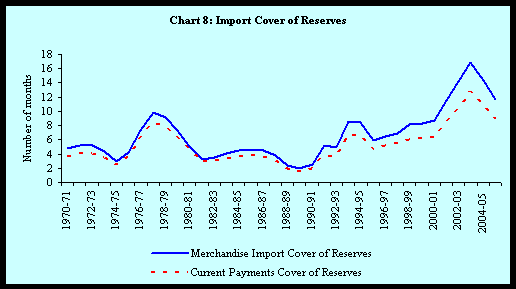
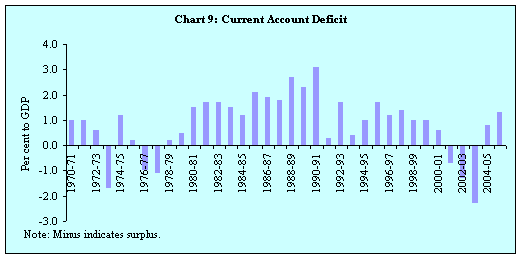
The growth in services receipts has been led by the significant expansion in software exports, and other professional and business services. Reflecting the sustained growth since the early 1990s, gross invisible receipts (i.e., services, transfers and income taken together) have expanded sharply from 2.4 per cent of GDP in 1990-91 to 11.5 per cent in 2005-06, outpacing the growth in merchandise exports (which increased from 5.8 per cent of GDP to 13.1 per cent over the same period). This has led to a rise in the share of invisibles in the current receipts (exports and invisibles combined) from 29 per cent in 1990-91 to 47 per cent in 2005-06 (Table 4). As a result, the ratio of current receipts to GDP has nearly trebled from 8.2 per cent in 1990-91 to 24.5 per cent in 2005-06. Reflecting the continued buoyancy of India’s services exports, the share of India’s services exports in world exports has trebled in the course of just a decade - from 0.6 per cent in 1995 to 1.8 per cent in 2004 (Chart 10). India was the 18th largest service exporter in the world in 2004. The gains recorded by the exports of services have far exceeded those recorded by exports of goods.
|
Table 4: India’s Invisible Receipts (US $ billion) |
||||
|
Year |
Services |
Transfers |
Income |
Invisibles Receipts/ |
|
1 |
2 |
3 |
4 |
5 |
|
1990-91 |
4.6 |
2.5 |
0.4 |
29 |
|
1995-96 |
7.3 |
8.9 |
1.4 |
35 |
|
2000-01 |
16.3 |
13.3 |
2.7 |
42 |
|
2001-02 |
17.1 |
16.2 |
3.4 |
45 |
|
2002-03 |
20.8 |
17.6 |
3.5 |
44 |
|
2003-04 |
26.9 |
22.7 |
3.9 |
45 |
|
2004-05 |
46.0 |
21.3 |
4.5 |
47 |
|
2005-06 |
60.6 |
25.2 |
5.7 |
47 |
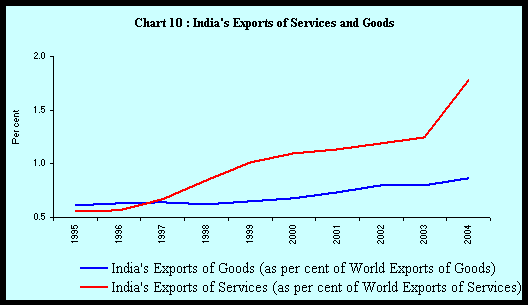
Foreign investment has increased from negligible levels till the early 1990s to 2.5 per cent of GDP by 2005-06 (Chart 11). Both direct and portfolio investment flows have recorded significant increases, although the inflows under direct investment remain relatively low compared to other recipient countries. The volume of FDI inflows into India is, however, growing on the back of growing interest by many of the world’s leading multinationals. India has improved its rank from fifteenth (in 2002) to become the second most likely FDI destination after China in 2005. Net capital flows received by India amounted to US $ 25 billion in 2005-06; gross capital inflows and outflows were much higher at US $ 139 billion and US $ 115 billion, respectively, pointing towards growing openness and integration of the Indian economy with the global economy. Consequently, global economic developments are likely to have more pronounced effects on the Indian economy than hitherto. Policies that take advantage of the growing openness while minimising the adverse consequences have been followed since early 1990s and these have served the country well so far. Indeed, not only is India a recipient of FDI inflows, but Indian companies are also increasingly investing abroad to take advantage of opportunities available in the global market. Outward FDI investment was as high as US $ 2.7 billion in 2005-06 and cumulative FDI investment abroad is estimated at US $ 12 billion at end-March 2006.
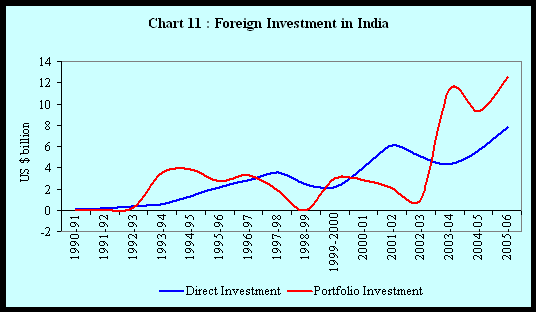
Public Finance
Public finances have exhibited a mixed trend in the reforms period. After witnessing some correction till 1996-97, public finances witnessed a deterioration, reflecting a variety of factors such as the decline in tax revenues (as per cent to GDP) in consonance with the cyclical downturn of economic activity, as well as the effects of the 5th Pay Commission award. Indeed, the combined fiscal deficit of the Centre and States was higher in 2001-02 than that in 1990-91 (Chart 12). Since 2002-03 onwards, public finances have witnessed a significant improvement, reflecting both policy efforts at fiscal consolidation as well as the upturn in economic activity. Notwithstanding this recent correction, combined public debt remains high (almost 79 per cent of GDP). Furthermore, capital expenditure remains low (Table 5) and the tax-GDP ratio, despite recent improvement, also remains low (Table 6 and Chart 13).
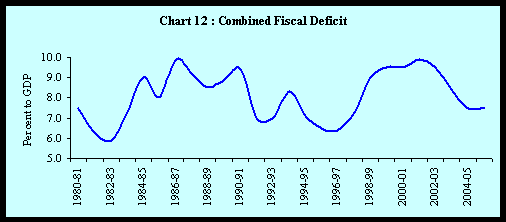
|
Table 5: Central Government’s Expenditure (Per cent to GDP) |
||
|
Year |
Revenue Expenditure |
Capital Outlay |
|
1 |
2 |
3 |
|
1970-71 |
6.9 |
2.1 |
|
1980-81 |
10.0 |
2.1 |
|
1990-91 |
12.9 |
2.1 |
|
1995-96 |
11.8 |
1.2 |
|
2000-01 |
13.2 |
1.2 |
|
2005-06 RE |
12.5 |
1.6 |
|
2006-07 BE |
12.4 |
1.7 |
|
Table 6: Gross Tax Revenues of the Centre |
|||
|
(Per cent to GDP) |
|||
|
Year |
Direct Tax |
Indirect Tax |
Total |
|
1 |
2 |
3 |
4 |
|
1990-91 |
1.9 |
8.2 |
10.1 |
|
1991-92 |
2.3 |
8 |
10.3 |
|
1992-93 |
2.4 |
7.5 |
10 |
|
1993-94 |
2.4 |
6.5 |
8.8 |
|
1994-95 |
2.7 |
6.5 |
9.1 |
|
1995-96 |
2.8 |
6.5 |
9.4 |
|
1996-97 |
2.8 |
6.6 |
9.4 |
|
1997-98 |
3.2 |
6.0 |
9.1 |
|
1998-99 |
2.7 |
5.6 |
8.3 |
|
1999-2000 |
3.0 |
5.8 |
8.8 |
|
2000-01 |
3.2 |
5.7 |
8.9 |
|
2001-02 |
3.0 |
5.2 |
8.2 |
|
2002-03 |
3.4 |
5.4 |
8.8 |
|
2003-04 |
3.8 |
5.4 |
9.2 |
|
2004-05 |
4.2 |
5.5 |
9.8 |
|
2005-06 (RE) |
4.8 |
5.7 |
10.5 |
|
2006-07 (BE) |
5.3 |
5.9 |
11.2 |
|
RE : Revised Estimates. BE: Budget Estimates. |
|||
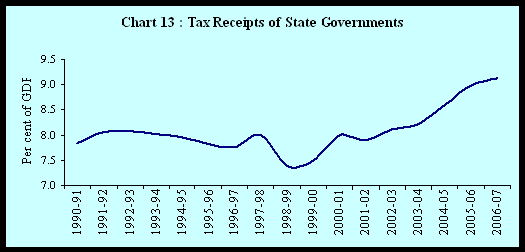
Financial Sector
The financial system in India, through a measured, gradual, cautious, and steady process, has undergone substantial transformation. It has been transformed into a reasonably sophisticated, diverse and resilient system through well-sequenced and coordinated policy measures aimed at making the Indian financial sector more competitive, efficient, and stable. It is noteworthy that despite a series of exogenous shocks such as the Asian crisis, sanctions due to nuclear explosions, the sharp rise in oil prices to record highs, large corrections in stock markets, financial stability has been maintained. The asset quality of the banking sector has recorded a significant improvement: the ratio of net non-performing assets to net advances has declined from 8.1 per cent at end-March 1997 to 2.0 per cent at end-March 2006 despite tightening of prudential norms. There is growing competition in the banking sector, as indicated by the rising share of private sector banks in total banking assets. The overall capital adequacy ratio of the banking sector as a whole has increased from 10.4 per at end-March 1997 to 12.8 per cent at end-March 2006. Operating expenses of scheduled commercial banks have declined from 2.1 per cent of total assets in 1992 to 1.8 per cent in 2004 indicative of improvements in efficiency. Intermediation cost of banks has declined from 2.9 per cent in 1995-96 to 2.1 per cent by 2005-06. The financial system is now robust and resilient, and is enabling accelerated economic growth in an environment of stability (Charts 14-17).
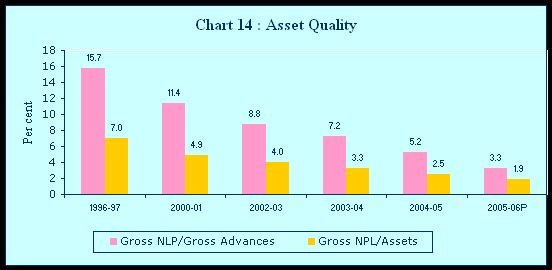
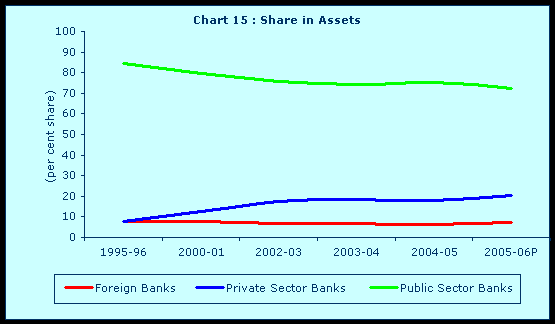
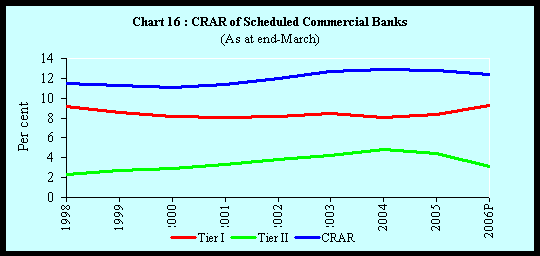
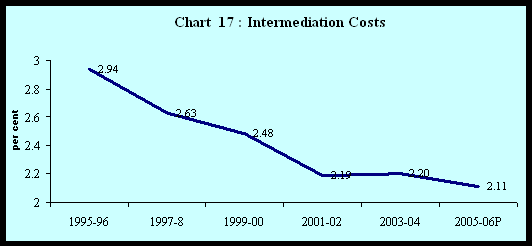
II. World Economic Situation
As noted earlier, the openness of the Indian economy has nearly trebled between 1990-91 and 2005-06. The Indian economy is thus now much more intertwined with the global economy. In order to assess the prospects for the domestic economy, it would, therefore, be relevant to review the prospects of the global economy.
According to the latest assessment of the IMF in its World Economic Outlook (September 2006), the global economy (using exchange rates based on purchasing power parities) is expected to record an accelerated growth of 5.1 per cent in 2006, higher than that of 4.9 per cent in 2005. This is the fourth successive year of strong, above trend, growth despite continuous headwinds form record high oil prices and elevated non-commodity prices. Global growth is expected to average 4.9 per cent per annum between 2003 and 2006, significantly higher than growth of 3.9 per cent registered between 1996 and 2000 and 2.8 per cent between 1991 and 1995. Headwinds from higher commodity prices have been offset by productivity gains across the world, in both developed and emerging economies, emanating from forces of globalisation, the ICT revolution, creation of global supply chains, greater efficiency in financial markets and better macroeconomic policies. Global growth has been led by the US and emerging economies led by China and India. A positive feature is that global economic activity is now becoming more balanced, with the euro area gaining momentum, along with sustained expansion in Japan. Economic activity in the US, on the other hand, is slowing down mainly on the back of a cooling housing market. Global economic growth is expected to maintain its recent above-trend growth in 2007; the IMF projects growth to be 4.9 per cent in 2007 (in PPP terms) (Charts 18 and 19). Concomitantly, growth in world trade has remained buoyant. World trade in goods and services in volume terms has increased by an average of 9 per cent per annum during 2004 and 2005 and is expected to grow by another 9 per cent in 2006.
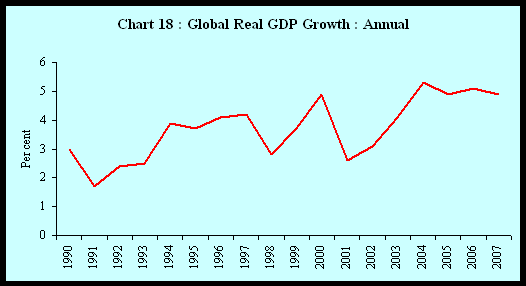
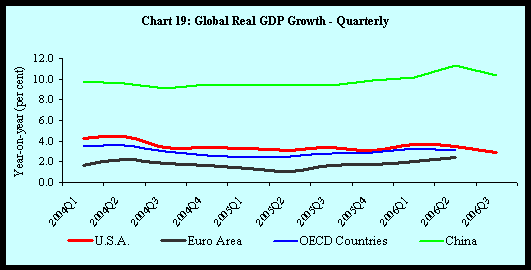
While global growth has remained strong, it faces a number of downside risks. One such risk emanates from high oil prices and commodity inflation. Globally, inflation has edged up reflecting higher oil and other commodity prices, but surprisingly, the impact has remained relatively muted compared to previous oil shocks. It is also worth stressing that since 2003 onwards, real interest rates are at very low levels in many countries and monetary and credit aggregates have been recording above trend growth. Yet, consumer price inflation has been relatively benign, even in the face of sharply higher oil and other commodity prices (Charts 20 and 21). This phenomenon has been aptly described as the "Great Liquidity Expansion Puzzle".
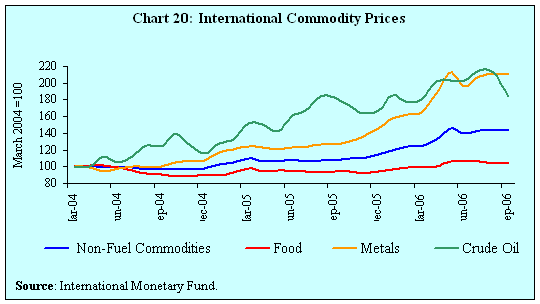
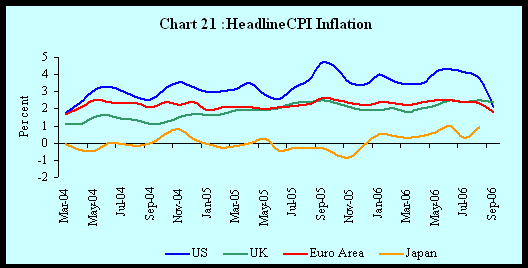
A number of factors explain as to why consumer price inflation has remained relatively modest despite higher oil and other commodity prices and abundant liquidity. Lower trade barriers, increased deregulation, innovation and competition and efficiency gains arising from global supply chains all over the world helped in containing inflationary pressures. With the rapid expansion in tradables, domestic economies are, therefore, increasingly exposed to the rigours of international competition and comparative advantage, reducing unwarranted price mark-ups. Productivity growth in a number of sectors, partly due to IT investments combined with restructuring, has also enabled absorption of higher costs. Fall in intensity of oil usage, and, in case of many emerging market economies, less-than-complete pass-through of oil prices have also helped to contain headline inflation. Finally, changes in the conduct of monetary policy frameworks such as inflation targeting regimes with greater focus on price stability and increased central bank credibility have contributed to keeping inflationary expectations largely stable and anchored at low levels.
Nonetheless, the cumulative impact of the past increases in oil and other commodity prices has led to headline inflation in many economies marginally exceeding their respective targets. Central banks have, therefore, been tightening their monetary policies to stabilise inflation expectations, especially since demand conditions have been strong and output gaps are closing in most of the economies (Chart 22). While the Federal Reserve in the US has paused since end-June 2006 after 17 successive hikes of 25 basis points each between June 2004 and June 2006, it has indicated that further tightening would depend upon the incoming information. The European Central Bank is anticipated to continue to tighten further, despite a pause in its latest meeting. Thus, global interest rates, which had eased significantly during 2002-2003, are likely to remain relatively higher in the short-term. Although in recent weeks, international crude oil prices have eased substantially to below US $ 60 a barrel, they still remain quite high and furthermore, the outlook remains uncertain. Moreover, although headline inflation in major advanced economies has indeed exhibited significant moderation during September 2006, core inflation continues to remain firm.
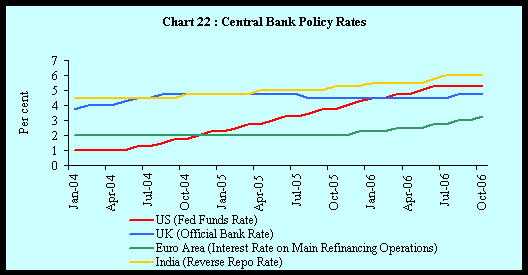
In brief, globally, both output growth and consumer price inflation are relatively more stable despite a series of supply shocks. On the other hand, commodity prices, exchange rates and other asset prices have exhibited heightened volatility. When inflation and interest rates are low, as is the case now, small changes in inflation expectations or interest rate expectations can lead to repricing of risks which can be quite large. In turn, this repricing of risks can lead to elevated volatility in asset prices, as was witnessed during May-June 2006.
III. Current Economic Situation: India
Against this backdrop of external outlook, it would be useful to have an assessment of the Indian economy for 2006-07, based on developments during 2006-07 so far. A review of the developments suggests that the Indian economy is on its way of achieving growth close to that witnessed during the past three years (Table 7).
|
Table 7 : India’s Real GDP Growth (Per cent) |
|||||||
|
Sector |
Full Year |
April-June |
|||||
|
|
|
(Base: 1999-2000) |
|
||||
|
|
|
2003-04 |
2004-05 (QE) |
2005-06 (RE) |
2005 |
2006 |
|
|
1 |
2 |
3 |
4 |
5 |
6 |
7 |
|
|
1 |
Agriculture and Allied Activities |
10.0 |
0.7 |
3.9 |
3.4 |
3.4 |
|
|
2 |
Industry |
6.6 |
7.4 |
7.6 |
9.5 |
9.7 |
|
|
2.1 |
Mining and Quarrying |
5.3 |
5.8 |
0.9 |
3.1 |
3.4 |
|
|
2.2 |
Manufacturing |
7.1 |
8.1 |
9.0 |
10.7 |
11.3 |
|
|
2.3 |
Electricity, Gas and Water Supply |
4.8 |
4.3 |
5.3 |
7.4 |
5.4 |
|
|
3 |
Services |
8.5 |
10.2 |
10.3 |
10.1 |
10.5 |
|
|
3.1 |
Construction |
10.9 |
12.5 |
12.1 |
12.4 |
9.5 |
|
|
3.2 |
Trade, Hotels and Restaurants, Transport, Storage and Communication |
12.0 |
10.6 |
11.5 |
11.7 |
13.2 |
|
|
3.3 |
Financing, Insurance, Real Estate and Business Services |
4.5 |
9.2 |
9.7 |
8.8 |
8.9 |
|
|
3.4 |
Community, Social and Personal Services |
5.4 |
9.2 |
7.8 |
7.3 |
9.5 |
|
|
4 |
Gross Domestic Product |
8.5 |
7.5 |
8.4 |
8.5 |
8.9 |
|
Agriculture
Assuming trend growth in agriculture under normal monsoon conditions and barring domestic or external shocks, the Reserve Bank in its Annual Policy Statement for 2006-07 (April 2006) placed real GDP growth, for policy purposes, in the range of 7.5-8.0 per cent during 2006-07. The Reserve Bank reaffirmed its forecast for GDP growth in July 2006 in its First Quarter Review of the Annual Statement on Monetary Policy. The Reserve Bank revised upwards its forecast for GDP growth to around 8.0 per cent in October 2006 in its Mid-Term Review on the back of improvement in industrial outlook and expected sustenance of growth momentum in services. Other agencies have also placed their growth estimates close to 8 per cent.
Industry and Infrastructure
Led by manufacturing, the upturn in the industrial sector is entering its fifth year of expansion in 2006-07. Manufacturing activity has remained stronger than expected in the current fiscal year so far. Based on movements in the index of industrial production (IIP), growth in manufacturing activity accelerated to 11.8 per cent during April-August 2006 from 9.6 per cent in the corresponding period of 2005. In terms of use-based classification, all sectors, excepting consumer non-durables have exhibited acceleration. Notably, growth in capital goods production accelerated to nearly 19 per cent, even on a high base, reflective of strong investment activity in the economy (Table 8).
|
Table 8: Index of Industrial Production |
|||||
|
Sector |
Weights in IIP |
Growth Rate (Per cent) |
|||
|
|
April-March |
April-August |
|||
|
|
|
2004-05 |
2005-06 |
2005 |
2006 |
|
1 |
2 |
3 |
4 |
5 |
6 |
|
IIP |
100.0 |
8.4 |
8.1 |
8.7 |
10.6 |
|
Basic Goods |
35.6 |
5.5 |
6.6 |
6.9 |
8.3 |
|
Capital Goods |
9.3 |
13.9 |
15.8 |
13.8 |
18.6 |
|
Intermediate Goods |
26.5 |
6.1 |
2.4 |
3.5 |
9.5 |
|
Consumer Goods |
28.7 |
11.7 |
12.0 |
13.7 |
11.3 |
|
i) Consumer Durables |
5.4 |
14.4 |
14.9 |
13.0 |
16.6 |
|
ii) Consumer Non-Durables |
23.3 |
10.8 |
11.1 |
13.9 |
9.5 |
On the other hand, the six infrastructure industries have recorded only modest improvement to 7.3 per cent during April-September 2006 from 6.1 per cent in the corresponding period of 2005. This improvement was helped by a turnaround in the production of crude oil and petroleum refinery products – these two sectors had registered negative growth a year ago. Electricity generation, coal, and oil production, however, remained subdued (Table 9).
|
Table 9 : Infrastructure Activity |
|||||
|
Weight in IIP |
Growth in |
||||
|
|
April-March |
April-September |
|||
|
Sector |
|
2004-05 |
2005-06 |
2005 |
2006 |
|
1 |
2 |
3 |
4 |
5 |
6 |
|
Electricity |
10.2 |
5.2 |
4.9 |
4.7 |
6.7 |
|
Coal |
3.2 |
6.2 |
7.0 |
6.0 |
5.3 |
|
Finished Steel |
5.1 |
8.4 |
8.0 |
13.7 |
7.2 |
|
Cement |
2.0 |
6.6 |
12.3 |
11.4 |
10.0 |
|
Crude Petroleum |
4.2 |
1.8 |
-5.3 |
-5.0 |
4.1 |
|
Petroleum Refinery Products |
2.0 |
4.3 |
2.1 |
-0.7 |
12.3 |
|
Composite Infrastructure Index |
26.7 |
5.8 |
5.3 |
6.1 |
7.3 |
The resilience shown by the industrial sector against the hardening of global oil prices is reflective of inherent strengths and capabilities that the industrial sector has built up over the years since the initiation of economic reforms in the country. There is evidence of growing competitiveness in respect of sectors such as automobiles and pharmaceuticals, with potential to emerge as a manufacturing base for global production. At the same time, in the face of challenges from infrastructural bottlenecks, elevated input costs from higher oil and other commodity prices, likely imports from China and the possibility of emerging shortages of domestic skilled labour, the domestic manufacturing sector will have to continuously improve its productivity and competitiveness in order to sustain the current growth momentum.
Corporate Profitability
In recent years, a striking feature of the Indian corporate sector is its growing engagement with the global economy. Apart from merchandise trade in goods and services, this growing integration has taken the form of large scale cross-border merger and acquisition activities. Thus, not only India is a recipient of foreign direct investment, but the corporate sector is also exploring opportunities to invest abroad. Following the phased liberalisation in the regime for Indian investments overseas, investments in joint ventures (JV) and wholly owned subsidiaries (WOS) abroad have emerged as important avenues for promoting global business by Indian companies. Indian firms are acquiring firms abroad to leverage comparative advantage of foreign locations, to acquire appropriate technologies and to have a marketing and distribution base with the ultimate objective of attaining economies of scale and productivity gains. As noted earlier, India’s direct investment overseas amounted to US $ 2.7 billion during the year (Chart 23). The value of acquisitions is, however, much higher since these data only capture the cross-border remittance of outward FDI from India. The number of Indian companies listed on stock exchanges abroad has seen a consistent increase. The growing integration of the Indian corporate sector is also visible from the trends in their exports and imports. The ratio of merchandise exports to sales trebled from 6.2 per cent in 1990-91 to 18.6 per cent by 2004-05 while the ratio of imports to sales has increased from 7.9 per cent to 21.6 per cent over the same period (Chart 24).
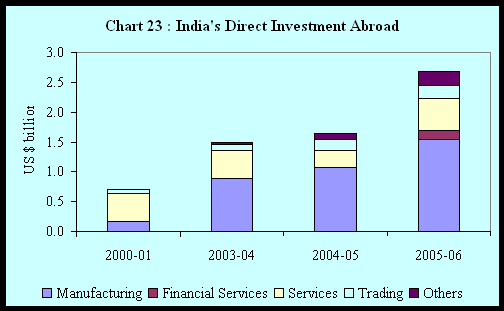
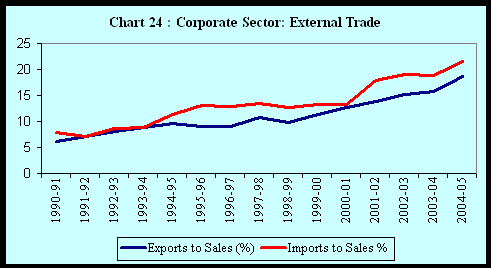
Corporate profitability has recorded strong growth for over three years now. Profits after tax of a sample non-financial non-Government companies recorded a growth of more than 40 per cent for 11 successive quarters from October-December 2002 to April-June 2005. Subsequently, growth in profitability decelerated over the next three quarters of 2005-06 on the back of rising input costs as well as higher debt servicing costs. Available information for 2006-07 suggests a reversal of the deceleration trend; growth in profits after tax accelerated to 35 per cent during April-June 2006 from around 15 per cent in the preceding quarter (Table 10). It is interesting that corporate profitability has remained strong, despite sharp rise in input costs. Perhaps, the strong profitability can be partly attributed to productivity gains. Looking ahead, a critical question is: how long can corporate profitability and productivity continue to exhibit buoyancy?
|
Table 10: Corporate Sector Performance (Growth rates, per cent) |
||||||||
|
Item
|
2003-04 |
2004-05 |
2005-06 |
2005-06 |
2006-07 |
|||
|
|
|
|
Q1 |
Q2 |
Q3 |
Q4 |
Q1 |
|
|
1 |
2 |
3 |
4 |
9 |
10 |
11 |
12 |
13 |
|
Sales |
16 |
24.1 |
16.9 |
18.5 |
16.4 |
13.2 |
19.5 |
25.6 |
|
Expenditure |
13.2 |
21.9 |
16.4 |
18 |
16.3 |
12.7 |
18.9 |
24.6 |
|
Gross Profit |
25 |
32.5 |
20.3 |
32 |
19.1 |
21.2 |
16.6 |
33.9 |
|
Interest Cost |
-11.9 |
-5.8 |
1.9 |
-13.5 |
-8 |
4.6 |
3.8 |
19.9 |
|
Profit After Tax |
59.8 |
51.2 |
24.2 |
54.2 |
27.5 |
27 |
15.1 |
34.7 |
|
Note : 1. Growth rates are percentage
change in the level for the period under reference over the corresponding
period of the previous year. |
||||||||
Recovery in domestic stock markets, buoyant corporate performance and business confidence all suggest that investment climate remains upbeat and this should support economic activity. There has been a large increase in investment intentions: the value of investment intentions registered in Industrial Entrepreneurs Memoranda have more than doubled from Rs.1,54,954 crore in 2003-04 to Rs. 3,82,743 crore in 2005-06. However, it remains to be seen as to how much of these investments fructify? Issues of financing of investments will also assume importance in this context as these investment intentions move towards fructification.
Banking Developments
Bank deposits as well as credit have recorded strong growth during the fiscal year 2006-07 indicative of strong demand conditions. Bank credit has continued to record year-on-year growth of over 30 per cent for more than a year. Bank credit has been largely broad-based, although some of the sectors such as housing and other retail and commercial real estate have expanded more rapidly. In this context, it would be relevant to note that the credit-GDP ratio in India - notwithstanding the sharp rise since 2000 - remains lower than in many Asian economies as well as in advanced economies. Deposit growth has accelerated, which could be attributed partly to higher interest rates on time deposits as well as extension of tax benefits for deposits above 5-year maturity. Concomitantly, growth in broad money (M3), y-o-y, at 19.0 per cent as on October 13, 2006 remains above the indicative trajectory of 15.0 per cent projected in the Annual Policy Statement (Table 11). By current indications, as the Reserve Bank noted in its Mid-Term Review (October 2006), the growth in monetary and credit aggregates is now expected to be somewhat higher than the initial indicative projections. In view of sustained demand for credit from the commercial sector, banks’ continue to restrict their incremental investments in Government securities. As a result, the banks’ holdings of SLR securities have declined to around 30 per cent as on October 13, 2006 from around 35 per cent a year ago. As the ratio approaches the statutory minimum of 25 per cent, the flexibility available to the banks by switching their asset portfolio in favour of credit to the commercial sector by restricting their incremental investments in SLR securities is, thus, getting progressively limited. In the context of sustained high growth in bank credit, the Reserve Bank has raised risk weights and provisioning requirements for sectors witnessing large credit growth. In view of the high credit growth, the Reserve Bank has also been drawing the attention of banks to the need to ensure asset quality in order to maintain financial stability.
|
Table 11 : Money and Credit (Per cent) |
||
|
Item |
Year on-Year Growth |
|
|
October 14, 2005 |
October 13, 2006 |
|
|
1 |
2 |
3 |
|
Broad Money |
16.8 |
19.0 |
|
Of which: |
||
|
Currency with Public |
14.6 |
17.3 |
|
Commercial Bank Deposits |
18.6 |
20.7 |
|
Commercial Bank Non-food Credit |
31.8 |
30.5 |
|
Commercial Bank Investment in Gilts |
5.9 |
2.5 |
Demand for bank credit is likely to remain strong in view of vast demands for financing the infrastructure investment, the growing size of the services sector, SMEs and rural enterprises. The emphasis on financial inclusion will also lead to enhanced need for financial intermediation. The corporate sector, in the coming years, is, therefore, likely to face greater competition for bank credit as the banks explore emerging avenues such as retail credit. The banking system has to respond adequately to these new challenges, opportunities and risks. Innovative channels for credit delivery for serving these new rural credit needs, encompassing full supply chain financing, covering storage, warehousing, processing, and transportation from farm to market will have to be found. In view of the expected large demand for bank credit, banks will have to simultaneously put in steps to increase deposit mobilisation. Concomitantly, it is important to keep monetary growth consistent with the requirements of price stability.
Inflation
Headline inflation during 2006-07 so far (5.4 per cent as on October 21, 2006) remains relatively contained, even as supply shocks from higher primary food articles prices have got accentuated. Primary articles inflation, year-on-year, has increased to 7.8 per cent on the back of higher prices of wheat, pulses and milk. As regards fuel prices, its impact on domestic inflation has petered out in recent weeks on the back of base effects. In this context, the recent decline in international crude oil prices, if sustained, is welcome. However, it needs to be noted that the pass-through of higher international crude oil prices to domestic prices remains incomplete as LPG and kerosene prices have remained unchanged since November 2004 and April 2002, respectively. Manufactured products inflation has also edged higher in recent months, although it remains relatively modest (Charts 25 and 26).
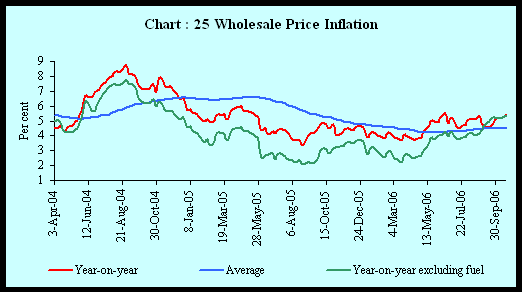
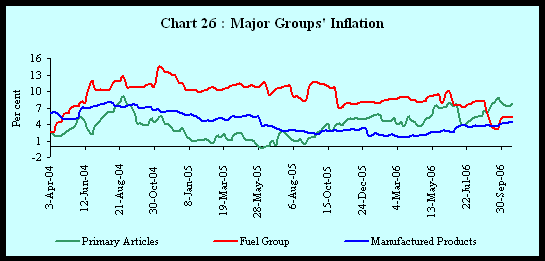
Various measures of consumer price inflation – which has a greater weight on prices of food articles – remain higher than that of wholesale price inflation. In order to contain inflationary expectations, the Reserve Bank increased the reverse repo rate as well as the repo rate by 25 basis points each in June 2006 and July 2006. The Reserve Bank increased the repo rate by another 25 basis points to 7.25 per cent in its Mid-term Review (October 2006) while leaving the reverse repo rate unchanged at 6.00 per cent – there has, thus, been a cumulative increase of 150 basis points in the reverse repo rate and 125 basis points in the repo rate since the tightening began in October 2004. The monetary measures have been supported by fiscal measures such as exempting imports of wheat, pulses and sugar from customs duty, reduction in customs duty on palm oils and restriction on exports of pulses. Pressures on primary articles prices, low stocks in case of wheat as well as shortfall in global production pose continuing challenges for monetary management. Furthermore, as the Mid-Term Review of the Annual Policy Statement for 2006-07 has observed, recent developments, in particular, the combination of high growth and consumer inflation coupled with escalating asset prices and tightening infrastructural bottlenecks underscore the need to reckon with dangers of potential overheating and the implications for the timing and direction of monetary policy setting. While there is no conclusive evidence of potential overheating in the Indian economy at the current juncture, the criticality of monitoring all available indications that point to excess aggregate demand is perhaps more relevant now than ever before.
The cumulative rainfall during the South-West monsoon season (June-September 2006) was close to normal; the inter-temporal as well as inter-spatial distribution, however, turned out to be uneven. As a result, kharif foodgrains output for 2006 is now anticipated to be almost four per cent below that achieved in 2005. Looking ahead, the total live water storage in the 76 major reservoirs as on October 12, 2006 at 90 per cent of the Full Reservoir Level remains higher than that of 81 per cent a year ago and portends well for the ensuing rabi crops. However, in a medium-term perspective, the stagnation in domestic foodgrains production in the recent years has emerged as a clear cause of concern, impinging both upon domestic demand as well as domestic prices. These issues are addressed in detail in the subsequent section.
External Sector
Finally, external sector developments indicate continued buoyancy in both merchandise and service exports, suggestive of growing competitiveness of Indian manufacturing and services. Oil imports have posted large growth so far, reflecting the further hardening of international crude oil prices until mid-August 2006. The recent easing of international crude oil prices, if sustained, could restrict the growth of oil imports going forward. Non-oil imports, on the other hand, have recorded a sharp deceleration, which could be partly attributed to imports of gold and silver (which declined by 30 per cent during April-June 2006 as against an increase of 52 per cent during April-June 2005). Imports of capital goods continued to record strong growth (38 per cent during April-June 2006). Capital flows have remained strong led by higher inflows under FDI, NRI deposits and issuances under ADRs/GDRs even as there were outflows by foreign institutional investors (FIIs). On the whole, India’s foreign exchange reserves have increased by US $ 14.5 billion in the current fiscal year so far to US $ 166.2 billion as on October 20, 2006.
Looking ahead, despite the growing oil import bill, the anticipated current account deficit in 2006-07 is manageable, as in the past, due to the continuing underlying strength of merchandise exports, invisibles and capital flows. The balance of payments is, therefore, expected to remain comfortable during 2006-07.
In brief, an assessment of the developments during 2006-07 so far suggests reinforcement of the robust economic growth exhibited in recent years. For the current growth momentum to be maintained and to be improved upon, a number of issues such as agriculture, infrastructure, and fiscal consolidation need to be addressed. These are discussed next.
IV. Issues
Instead of summarising my remarks, let me flag some issues that are going to be rather important in the days to come.
Agriculture
The agriculture sector in the recent years has been marked by low and volatile growth – real GDP growth in the agricultural sector during the first four years of the Tenth Five Year Plan has averaged only two per cent per annum as against four per cent envisaged in the Plan period (2002-07). A key factor underlying this low and volatile growth is the stagnation in domestic production in the case of major crops like wheat, sugar and pulses. Illustratively, the production of wheat after touching a peak of 76 million tonnes (mt) in 1999-2000 has since then been range-bound at around 70 mt. Similarly, the production of pulses has not been able to exceed the peak of 14.9 mt reached in 1998-99. The production of pulses at 13.1 mt in 2005-06 was even lower than the levels achieved more than 15 years back (14.3 mt in 1990-91). The stagnation in production, in turn, can be partly attributed to stagnancy in investment in the agricultural sector which, at constant (1999-2000) prices, at Rs.43,123 crore in 2004-05 was even lower than that of Rs.43,473 crore in 1999-2000. As a result, the ratio of investment to GDP fell from 2.2 per cent in 1999-2000 to 1.7 per cent in 2004-05 (Chart 27).
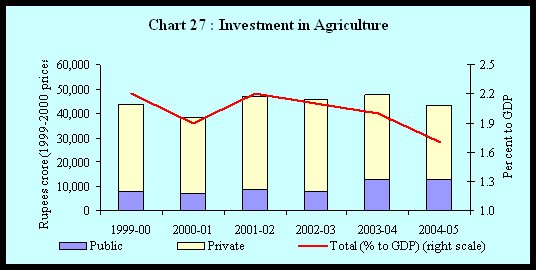
For the Indian economy to attain growth rates of 8 per cent and above, the stagnation in production of major crops and agricultural investment needs to be reversed. First, investment outlays on irrigation facilities need to be stepped up along with focus on efficient use of water resources. In this context, appropriate pricing of power can be helpful in avoiding the excessive use of ground water. Second, given the several risks that farmers face such as future price and monsoon conditions, there is a need to put in place proper risk mitigation policies. Third, greater focus on rural infrastructure is required to enhance the productivity of physical resources, and improve supply chain management and value addition in agriculture. Improvements in rural infrastructure will facilitate food processing and other agro-based industries. In this context, the focus on rural infrastructure development under Bharat Nirman is welcome. Fourth, globalisation, rising income, and urbanisation call for increasing diversification and value addition in Indian agriculture. The shifts in consumption pattern warrant a shift of land and other resources to crops with higher potential for value addition. Fifth, effective linkages of production systems with marketing, agro-processing and other value added activities would play an increasingly important role in diversification of agriculture. Sixth, more focus needs to be placed on agricultural research in the coming years as the success so far has been restricted to select crops. Finally, the Reserve Bank is intensifying its efforts in revitalising the rural cooperative credit system, strengthening regional rural banks, providing incentives to commercial banks for investments in rural economy and ensuring an adequate and timely delivery of credit at an appropriate price. Higher growth and stability in the agricultural sector will also provide a strong demand impetus for the non-agricultural sector (RBI, Annual Report, 2005-06).
Infrastructure
The sustenance and strengthening of the ongoing manufacturing resurgence will depend critically upon improvements in infrastructure facilities in a number of areas. Improvements that have taken place in infrastructure facilities in areas such as telecommunications, civil aviation, roads and, to some extent, ports and railways would need to be extended to the power sector. Electricity generation continues to be hampered by policy shortcomings, continued excessive transmission and distribution losses, and collection of dues along with emerging difficulties in the availability of coal and gas. Unreliable supply of power and that too at higher tariffs vis-à-vis other countries such as China can have adverse implications for competitiveness of the domestic manufacturing sector.
Provision of urban infrastructure facilities also needs greater attention. Globally, cities have consistently provided the environment for institutional and technological innovation, and acted as engines of economic growth. In this context, it may be noted that, in the last century, India did not face an "urban explosion" as against rapid urbanization across the globe. India’s level of urbanisation increased from 17.6 per cent in 1951 to only 23.7 per cent in 1981 and 27.8 per cent in 2001. Consistent with its low per capita income India ranks among the last thirty in the list of countries listed according to their urbanisation levels. Despite its low level of urbanisation, India’s urban population has grown to more than 285 million in 2001, close to 28 per cent of the total population of the country. In the last decade the overall increase in population has been particularly large at about 70 million people, which is larger than the urban population of all countries except Brazil, China, Indonesia, Russia, and the United States. Therefore, even though India’s level of urbanisation continues to be low and its urban population growth rate is not among the fastest in the world, the magnitude of urbanisation in India per se is large. Moreover, most of the growth in urban population has been due to the enlargement of existing towns at every level and not significantly due to the addition of new towns. This stable, rather static, situation has resulted in a stable city primacy hierarchy, but is also accompanied with vast areas of the country still continuing to be devoid of urban settlements of any size leading to extremely low levels of urbanisation of 10-15 percent in these regions (Table 12).
|
Table 12: Trends in Urbanisation (Population in millions) |
|||||
|
Year |
Number of |
Total |
Rural |
Urban |
Urban/ |
|
1 |
2 |
3 |
4 |
5 |
6 |
|
1901 |
1,830 |
238 |
213 |
26 |
10.8 |
|
1911 |
1,815 |
252 |
226 |
26 |
10.3 |
|
1921 |
1,944 |
251 |
223 |
28 |
11.2 |
|
1931 |
2,066 |
279 |
246 |
34 |
12.0 |
|
1941 |
2,253 |
319 |
275 |
44 |
13.0 |
|
1951 |
2,822 |
361 |
299 |
62 |
17.3 |
|
1961 |
2,334 |
439 |
360 |
79 |
18.0 |
|
1971 |
2,567 |
548 |
439 |
109 |
19.9 |
|
1981 |
3,347 |
683 |
524 |
160 |
23.3 |
|
1991 |
3,769 |
846 |
629 |
218 |
25.7 |
|
2001 |
4,378 |
1,027 |
742 |
285 |
27.8 |
Studies show that doubling of city size is associated with large productivity gains of 3-8 per cent, i.e., moving from a city of 100,000 inhabitants to one of 10 million is predicted to increase productivity by more than 40 per cent. These benefits emanate from the proximity to product as well as labour markets; proximity provides savings in trade and transport costs on the one hand and the availability of skilled labour on the other hand. Economic concentration economises on infrastructure investment that would have been larger had it been spread out over a larger part of the country. Thus, the evidence suggests that urban agglomerates provide large productivity gains. Accordingly, substantial improvement in the quality, governance and management of urban infrastructure in the country is essential for India to maintain and accelerate the momentum of economic growth and productivity.
Human Resource Development
Finally, substantial improvements in primary and secondary educational facilities available in the country will be necessary to accelerate the current growth momentum as well as to reap the benefits of the expected demographic dividend. Moreover, a renewed emphasis on quality higher education is necessary in view of the greater concentration of economic activities in the skill-intensive sectors, both in the industry and the services.
Fiscal Responsibility
The success in achieving fiscal consolidation, as observed earlier, has been mixed since the early 1990s. Against this backdrop, the progress on fiscal consolidation in the past three years is heartening. Indeed, the turnaround in public sector savings of 4.2 percentage points – from a negative 2.0 per cent of GDP in 2001-02 to a positive 2.2 per cent in 2004-05 – has been the predominant factor in improvement of overall savings to above 29 per cent and of investment rate to above 30 per cent. Fiscal consolidation is expected to improve savings further while also permitting productivity and efficiency gains as more resources become available for the private sector.
The progress in Central Government finances during the first five months of 2006-07 (April-August 2006) indicates that the key deficit indicators, as proportion to budget estimates, were higher than in the corresponding period of 2005-06. The widening of deficits was essentially on account of large growth in non-Plan revenue expenditures - higher interest payments, higher food and fertiliser subsidies and grants to States - which more than offset the buoyant tax collections under corporation tax, income tax and customs duties. The Government has, however, reiterated that the deficit targets set under the FRBM would be met with an evening out of revenues and expenditures over the course of the year.
Given the downward rigidity in revenue expenditure and sluggishness in non-tax receipts, the scope for deepening fiscal empowerment lies in improving tax revenue. In this context, the reversal of the declining trend in gross tax-GDP ratio is welcome. Gross tax/GDP ratio of the Centre after falling to a low of 8.2 per cent in 2001-02 has since increased to 11.2 per cent, the highest since 1990-91. This increasing trend needs to be maintained through further widening of the tax base and curtailment in tax exemptions. Larger deficit reductions in 2007-08 and 2008-09 will be required to meet the FRBM targets. As the Reserve Bank in its latest Annual Report has observed, adhering to the FRBM targets in respect of fiscal deficit and revenue deficit is critical for macroeconomic, financial, external sector and budgetary sustainability. It is essential to eliminate revenue deficit and generate sufficient revenue surplus which may be utilised for asset creation without creating liabilities. Any slippage in achieving the FRBM targets could erode the gains achieved in the initial year of the FRBM. It could also generate a chain effect at the State levels to relax targets set out in their fiscal responsibility legislations. Any deviation from the FRBM targets will have both national and international repercussions in terms of credibility.
As in the case of the Centre, the States will also need to focus on fiscal empowerment, i.e., expand the scope and size of revenue flows into budget. In particular, augmenting non-tax revenues through appropriate user charges and restructuring of State public sector undertakings (PSUs) continues to be of critical importance. Higher user charges will, however, not be feasible unless there is a greater efficiency in the delivery of the services provided by the States. Therefore, improving delivery of public services should be a priority for the State Governments.
The various measures aimed at improving tax collections are expected to reduce revenue deficits of the Government sector. The combined revenue deficit must be brought to zero in order to release more resources for investment, both by the public and the private sectors.
Public Services Delivery
Given the large infrastructure requirements and given the public good nature of such projects, the public sector will always have significant presence in the provision of infrastructure. Thus, infrastructural projects such as roads, urban infrastructure (water supply, sewerage, public lighting and urban transportation), railways and ports and airports will continue to need to be funded by public sector funds, although in some cases there is some scope for private sector in areas such as railways. This requires greater focus on improvement in delivery of public services.
Inaugural Address of Dr. Rakesh Mohan, Deputy Governor, RBI at the 2nd Annual Indian Securities Infrastructure & Operations Forum 2006 at Mumbai on November 7, 2006.

















